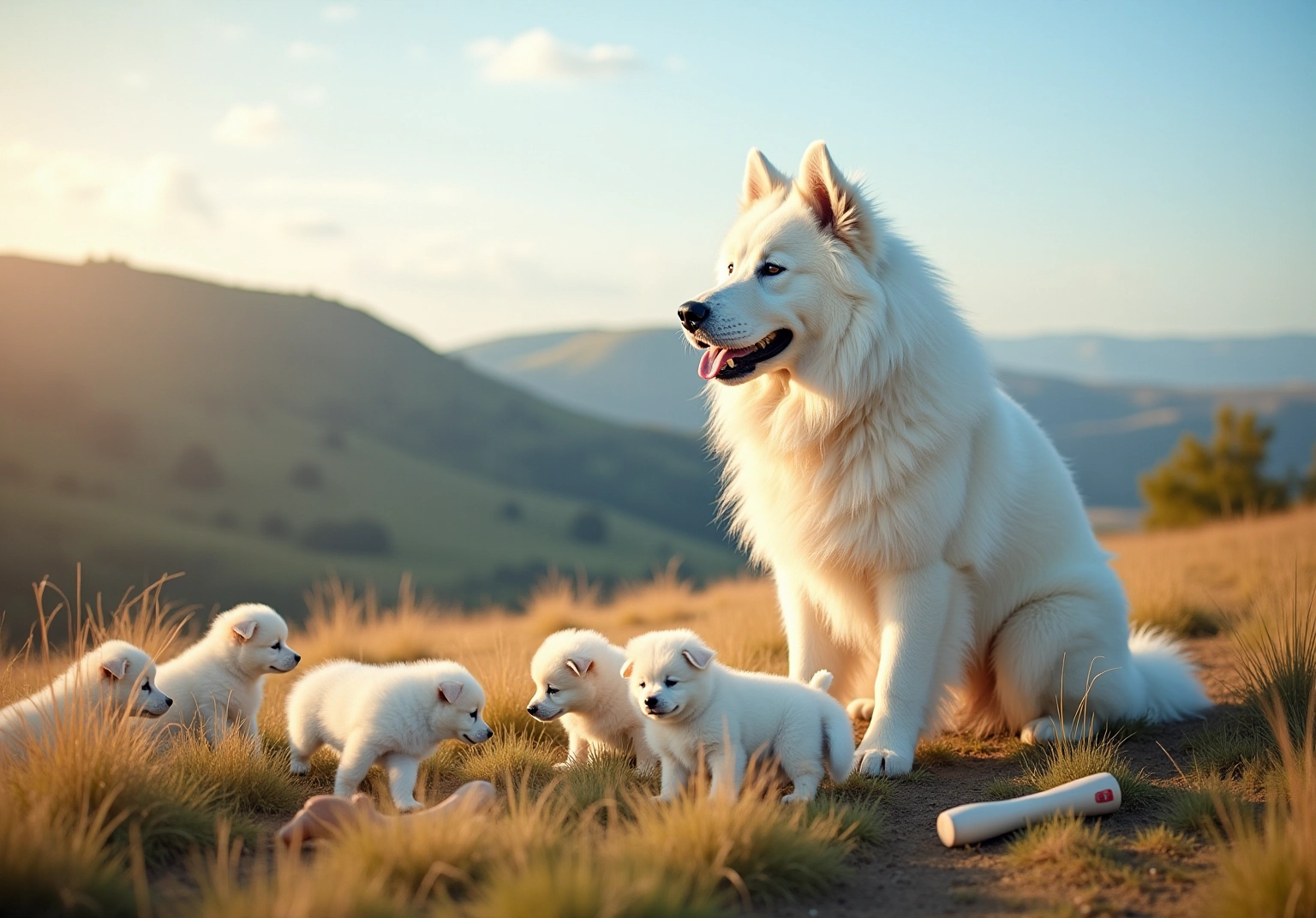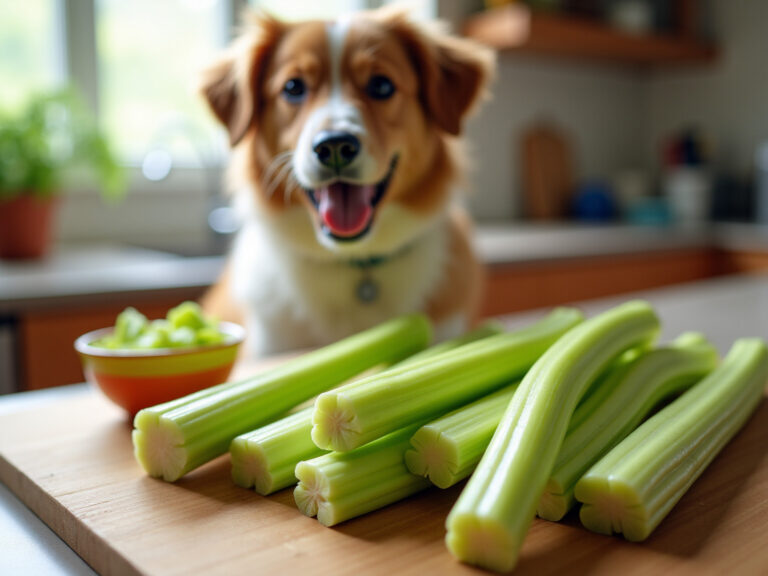Understanding Big White Dog Breeds: Characteristics and Care Needs
Overview
Big white dog breeds, with their impressive size, fluffy white coats, and gentle temperaments, make wonderful companions, guardians, and working dogs. As you consider welcoming one of these furry family members into your home, it’s important to acknowledge their unique care needs. Understanding grooming, exercise, and health considerations is essential for fostering a nurturing environment that supports their well-being. This not only enhances the bond between you and your pet but also ensures a happy, fulfilling life together.
At Adventure Den, we recognize that caring for these magnificent dogs can feel overwhelming. However, with the right guidance and support, you can confidently provide the love and care they deserve. By focusing on their specific needs, you can create a space where they thrive, bringing joy and companionship into your life. Remember, your commitment to their care is a journey filled with rewarding moments and deep connections.
If you’re ready to embark on this journey, we invite you to explore the resources and support available at Adventure Den. Together, we can ensure that your big white dog flourishes in a nurturing environment, enriching both your lives with love and companionship.
Introduction
The allure of big white dog breeds captivates many, drawing them in with their striking appearance and gentle temperaments that make them ideal companions. These majestic canines, from the Great Pyrenees to the Samoyed, not only boast beautiful coats but also possess unique characteristics that require thoughtful care and attention.
As you consider welcoming one of these gentle giants into your home, it’s essential to understand their specific needs and challenges. What essential traits and care strategies must you embrace to ensure a fulfilling and healthy life for your furry family members?
At Adventure Den, we are here to guide you every step of the way, ensuring a nurturing environment for your beloved pets.
Defining Big White Dog Breeds
Big white dog breeds encompass a variety of larger canine breeds, each distinguished by their beautiful white coats. Examples of big white dog breeds include the Pyrenees, Samoyed, Kuvasz, Maremma Sheepdog, and Slovensky Cuvac. These breeds, known as big white dog breeds, are cherished not only for their impressive size and fluffy appearance but also for their gentle demeanor and versatility in roles such as companionship, guarding, and working alongside humans.
For instance, the Great Pyrenees is classified among big white dog breeds, typically weighing between 85 to 100 pounds and known for its calm and protective nature, making it an excellent family companion. The Samoyed, weighing around 35 to 65 pounds, is recognized for its friendly disposition and unwavering loyalty. The Kuvasz, which is classified among the big white dog breeds, weighs between 100 to 115 pounds for males and requires weekly grooming to maintain its thick coat. The Maremma Sheepdog is one of the big white dog breeds that can weigh between 70 to 195 pounds and is celebrated for being brave and reliable.
Both the Great Pyrenees and Samoyed thrive with regular grooming and exercise to ensure their health and happiness. Understanding the unique characteristics and care needs of big white dog breeds is crucial for potential owners, as it enables them to create the best nurturing environment for their furry family members. Regular veterinary guidance emphasizes the importance of socialization and training for big white dog breeds, as these breeds flourish in organized settings that cater to their energetic and loving dispositions.
Veterinarians often highlight the protective instincts of big white dog breeds such as the Great Pyrenees and the loyalty of the Samoyed as key traits that make them exceptional family pets. By recognizing these qualities, you can ensure a rewarding companionship with these wonderful breeds, fostering a bond that enriches both your life and theirs.

Key Characteristics of Big White Dog Breeds
Big white dog breeds are truly remarkable, not just for their impressive physical features but also for their gentle temperaments. Weighing between 70 to over 100 pounds, big white dog breeds possess a robust build that is both strong and imposing, making them wonderful companions. Take the Kuvasz, for instance; it is one of the big white dog breeds that weighs between 70 to 115 pounds and is celebrated for its independent nature and protective instincts. Their thick, fluffy coats provide insulation against the cold, with the Pyrenees standing out for its double coat that is not only weather-resistant but also exceptionally beautiful.
Historically, the Pyrenees, which are one of the big white dog breeds, evolved from cherished white mountain dogs, and in 1675, it was honored as the ‘Royal Dog of France’ by King Louis XIV’s court. These gentle giants are known for their calm demeanor and friendly nature, often displaying a protective instinct towards their families, which makes them excellent companions for children. However, their independent streak can sometimes pose challenges. Consistent training and early socialization are essential in helping them adapt to family life. For example, big white dog breeds such as the Great Pyrenees thrive when given structured training and social interactions, while the Samoyed, known for its playful disposition, requires regular exercise and mental stimulation to keep boredom at bay.
Real-life experiences highlight the importance of positive reinforcement in training these beloved breeds, ensuring they grow into well-adjusted family members. Experts like Dr. Noah Reisman and Dr. Abraham Sanders emphasize that understanding the unique needs of these gentle giants—such as their susceptibility to bloat and the necessity of regular grooming—is crucial in fostering a nurturing relationship between them and their owners. By embracing their needs, you can create a loving environment for your furry family members.

Care Needs for Big White Dog Breeds
Caring for big white dog breeds involves attention to several key factors that ensure their happiness and health. Grooming is vital due to their thick coats, which can easily mat without regular maintenance. It’s advisable to brush these furry family members at least once a week, with increased frequency during shedding seasons to keep their fur healthy and manageable. For instance, Great Danes, towering at heights of up to 32 inches and weighing as much as 175 pounds, require regular grooming to maintain their majestic appearance.
These wonderful companions also have significant exercise needs; daily walks and playtime are crucial to ensure they remain healthy and content. According to expert DiNardo, Rottweilers are intelligent and compassionate animals, highlighting the importance of understanding their exercise requirements. Nutrition plays an essential role as well, especially since big white dog breeds are particularly vulnerable to health issues such as hip dysplasia and bloat. Offering a balanced diet specifically designed for larger dogs can help reduce these risks and promote a long, fulfilling life.
Regular veterinary check-ups are essential for monitoring their health and addressing any potential concerns early, ensuring that these noble companions lead long, fulfilling lives. Additionally, using high-quality grooming tools tailored to their coat types can effectively manage their thick fur, further enhancing their overall well-being. By providing the right care, you can create a nurturing environment that allows your beloved pets to thrive.

Common Health Issues in Big White Dog Breeds
Health challenges are often faced by big white dog breeds, primarily linked to their size and genetic traits. One significant concern is hip dysplasia, a condition impacting the development of the hip joint, which can lead to arthritis and chronic pain. Recent studies reveal that the incidence of canine hip dysplasia (CHD) varies among breeds, with some large varieties showing a notable decrease in dysplastic cases due to improved breeding practices. For example, the prevalence of CHD in Golden Retrievers has dropped from 25% to 9% between 1995-1999 and 2010-2016, underscoring the positive effects of selective breeding on health outcomes.
Bloat, or gastric torsion, poses another serious risk for large breeds, especially those with deep chests like Great Danes. Statistics indicate that approximately 39% of Danes will experience bloat during their lives, making it essential for owners to recognize the signs, which include pacing, agitation, and attempts to vomit. Immediate veterinary attention is vital, as untreated bloat can lead to tragic consequences within hours. To help prevent bloat, it is advisable for Great Danes to be fed two or three smaller meals each day instead of one large meal.
Additionally, skin sensitivities are prevalent in breeds with light-colored coats, rendering them more susceptible to sunburn and other skin issues. Regular veterinary check-ups, a balanced diet, and maintaining a healthy weight are crucial strategies for reducing these risks. By being proactive in their care, owners can help ensure that their big white dog breeds enjoy long, healthy lives. Remember, your furry family members deserve the best care possible, and at Adventure Den, we are here to support you every step of the way.

Conclusion
Big white dog breeds embody a unique blend of beauty, strength, and gentle temperament, making them cherished companions for many families. Their striking white coats and impressive sizes not only capture attention but also reflect their rich history and versatility in various roles, from guardians to loyal friends. Understanding the specific characteristics and care needs of these breeds is essential for creating a nurturing environment that allows your furry family members to thrive.
Throughout the article, key points have been highlighted regarding the various big white dog breeds, including their:
- Size
- Grooming requirements
- Exercise needs
- Common health issues
From the calm and protective nature of the Great Pyrenees to the playful loyalty of the Samoyed, each breed offers distinct qualities that contribute to their appeal. Additionally, the importance of regular veterinary care, proper nutrition, and consistent training cannot be overstated, as these factors significantly impact their overall well-being.
In conclusion, embracing the responsibility of caring for big white dog breeds involves a commitment to understanding their unique needs and characteristics. By fostering a supportive and loving environment, owners can cultivate a rewarding relationship with these gentle giants. For those considering adding a big white dog to their family, thorough research and preparation will ensure that both the dog and the owner enjoy a fulfilling companionship that enriches their lives.
Frequently Asked Questions
What are big white dog breeds?
Big white dog breeds refer to a variety of larger canine breeds characterized by their beautiful white coats. Examples include the Great Pyrenees, Samoyed, Kuvasz, Maremma Sheepdog, and Slovensky Cuvac.
What are some characteristics of the Great Pyrenees?
The Great Pyrenees typically weighs between 85 to 100 pounds and is known for its calm and protective nature, making it an excellent family companion.
How much does a Samoyed weigh and what is its temperament?
A Samoyed weighs around 35 to 65 pounds and is recognized for its friendly disposition and unwavering loyalty.
What is the weight range for a Kuvasz and what care does it require?
The Kuvasz weighs between 100 to 115 pounds for males and requires weekly grooming to maintain its thick coat.
What is notable about the Maremma Sheepdog?
The Maremma Sheepdog can weigh between 70 to 195 pounds and is celebrated for being brave and reliable.
What are the grooming and exercise needs for big white dog breeds?
Breeds like the Great Pyrenees and Samoyed thrive with regular grooming and exercise to ensure their health and happiness.
Why is understanding the care needs of big white dog breeds important for potential owners?
Understanding their unique characteristics and care needs helps potential owners create the best nurturing environment for their furry family members.
What do veterinarians emphasize about the training of big white dog breeds?
Veterinarians highlight the importance of socialization and training for big white dog breeds, as they flourish in organized settings that cater to their energetic and loving dispositions.
What key traits make big white dog breeds exceptional family pets?
The protective instincts of breeds like the Great Pyrenees and the loyalty of the Samoyed are key traits that make them exceptional family pets.







